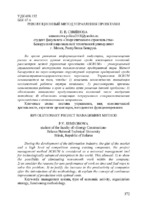| dc.contributor.author | Семёнова, П. В. | ru |
| dc.coverage.spatial | Минск | ru |
| dc.date.accessioned | 2019-12-03T12:08:43Z | |
| dc.date.available | 2019-12-03T12:08:43Z | |
| dc.date.issued | 2019 | |
| dc.identifier.citation | Семёнова, П. В. Революционный метод управления проектами = Revolutionary project management method / П. В. Семёнова // Экономика строительного комплекса и городского хозяйства [Электронный ресурс] : материалы международной научно-практической конференции / редкол.: О. С. Голубова [и др.]. – Минск : БНТУ, 2019. – С. 372-375. | ru |
| dc.identifier.uri | https://rep.bntu.by/handle/data/61270 | |
| dc.description.abstract | Во время развития информационной индустрии, перенасыщения рынка и высокого уровня конкуренции среди имеющихся компаний рассмотрен метод управления проектами «SCRUM» – универсальный управленческий инструмент технологичных предприятий мира. Метод базируется на пересмотрении структурной иерархии предприятий среди административно-управленческого персонала. Управления SCRUM основывается на том, чтобы: 1) показать возможность ликвидации неслаженной работы внутри компании; 2) рассмотреть причины невыполнения работы в срок и найти пути решения данной проблемы; 3) обосновать повышение продуктивности компаний после внедрения методики; 4) объяснить концепцию непрерывного совершенствования производства с оптимальными затратами. | ru |
| dc.language.iso | ru | ru |
| dc.publisher | БНТУ | ru |
| dc.title | Революционный метод управления проектами | ru |
| dc.title.alternative | Revolutionary project management method | ru |
| dc.type | Working Paper | ru |
| local.description.annotation | During the development of the information industry, the glut of the market and a high level of competition among existing companies, the project management method SCRUM is considered as a universal management tool for technologically advanced enterprises in the world. This allowed: 1) to show the possibility of eliminating non-smooth work within the company; 2) to consider the reasons for non-performance of work on time and find ways to solve this problem; 3) to justify the increase in the productivity of companies after the introduction of the methodology; 4) explain the concept of continuous improvement of production with optimal costs. | ru |

